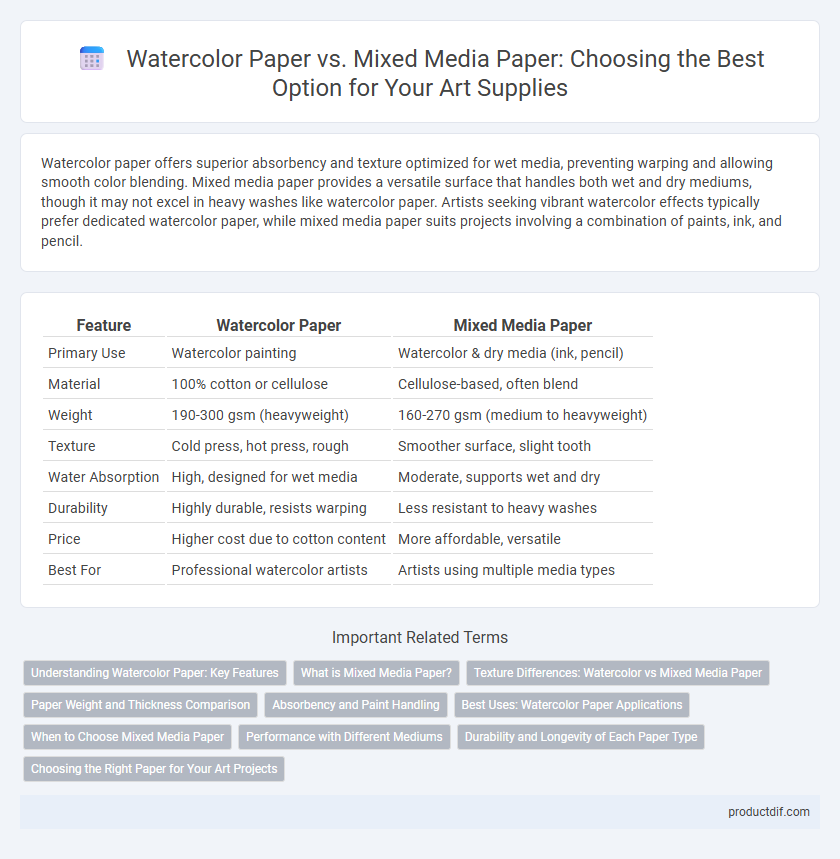Watercolor paper offers superior absorbency and texture optimized for wet media, preventing warping and allowing smooth color blending. Mixed media paper provides a versatile surface that handles both wet and dry mediums, though it may not excel in heavy washes like watercolor paper. Artists seeking vibrant watercolor effects typically prefer dedicated watercolor paper, while mixed media paper suits projects involving a combination of paints, ink, and pencil.
Table of Comparison
| Feature | Watercolor Paper | Mixed Media Paper |
|---|---|---|
| Primary Use | Watercolor painting | Watercolor & dry media (ink, pencil) |
| Material | 100% cotton or cellulose | Cellulose-based, often blend |
| Weight | 190-300 gsm (heavyweight) | 160-270 gsm (medium to heavyweight) |
| Texture | Cold press, hot press, rough | Smoother surface, slight tooth |
| Water Absorption | High, designed for wet media | Moderate, supports wet and dry |
| Durability | Highly durable, resists warping | Less resistant to heavy washes |
| Price | Higher cost due to cotton content | More affordable, versatile |
| Best For | Professional watercolor artists | Artists using multiple media types |
Understanding Watercolor Paper: Key Features
Watercolor paper is specifically designed to absorb water without warping, featuring a heavier weight and a textured surface that enhances paint adherence and color vibrancy. It typically comes in three main textures: rough, cold press, and hot press, each offering unique effects for different watercolor techniques. The high cotton content in quality watercolor paper provides durability and prevents pilling, making it ideal for repeated washes and blending.
What is Mixed Media Paper?
Mixed media paper is specifically designed to accommodate a variety of artistic techniques, combining the absorbency of watercolor paper with the sturdiness needed for heavier mediums like acrylics, inks, and markers. Its textured surface resists warping and bleeding, providing versatility for both wet and dry applications without compromising durability. Artists favor mixed media paper for its ability to support layered compositions and diverse media interactions within a single artwork.
Texture Differences: Watercolor vs Mixed Media Paper
Watercolor paper typically features a highly textured surface, such as cold-pressed or rough finishes, designed to absorb and hold watercolor pigments effectively, enhancing color vibrancy and blending. Mixed media paper usually offers a smoother texture with moderate tooth, allowing versatility for various mediums like ink, markers, and light watercolor washes without excessive paper warping. This texture difference significantly impacts pigment absorption and the overall appearance of the artwork.
Paper Weight and Thickness Comparison
Watercolor paper typically ranges from 190 to 300 gsm, offering substantial thickness and durability essential for heavy washes and wet techniques without buckling. Mixed media paper usually falls between 160 and 200 gsm, providing moderate thickness suitable for both wet and dry media but less resistant to extensive water exposure. The heavier weight and higher thickness of watercolor paper make it the preferred choice for water-based techniques, while mixed media paper balances versatility and texture for diverse artistic applications.
Absorbency and Paint Handling
Watercolor paper is engineered with high absorbency to hold water and pigment effectively, allowing smooth blending and vibrant color intensity. Mixed media paper offers moderate absorbency, balancing water handling with the ability to support various dry and wet mediums without warping. Artists seeking precise control over watercolor washes prefer the specialized texture and moisture retention of watercolor paper, while mixed media paper suits versatile techniques requiring both wet and dry application.
Best Uses: Watercolor Paper Applications
Watercolor paper, made from 100% cotton or cellulose, offers superior absorbency and texture ideal for wet media techniques like watercolor, gouache, and ink washes. Its heavyweight and cold-pressed or hot-pressed surfaces prevent warping and ensure vibrant pigment retention, making it perfect for detailed washes and blending. Artists focusing specifically on watercolor painting benefit from its ability to handle multiple layers without degrading the paper quality, unlike mixed media paper designed for combining dry and wet media but less specialized for heavy watercolor use.
When to Choose Mixed Media Paper
Mixed media paper is ideal when combining wet and dry media, such as watercolor, ink, and colored pencils, allowing artists to experiment without the paper warping or tearing. It offers a balanced texture and weight, typically around 200 gsm or higher, providing durability for layering techniques and mixed applications. Choose mixed media paper for versatility in projects requiring both water-based and dry artistic materials on a single surface.
Performance with Different Mediums
Watercolor paper excels in absorbing and holding water-based paints like watercolors and gouache, preventing warping and allowing vibrant color blending. Mixed media paper offers a versatile surface compatible with wet and dry mediums, including acrylics, ink, markers, and pastels, balancing durability and texture for varied techniques. Artists seeking optimal performance with specific mediums should consider the paper's weight, texture, and absorbency to match their creative needs.
Durability and Longevity of Each Paper Type
Watercolor paper, made from 100% cotton or a cotton blend, offers superior durability and longevity due to its thickness and ability to withstand heavy washes without warping or deteriorating over time. Mixed media paper, typically lighter and composed of cellulose or a cotton blend, provides moderate durability suited for multiple techniques but may show wear and degrade faster with prolonged exposure to water and heavy layering. The archival quality of watercolor paper makes it the preferred choice for artists seeking long-lasting, museum-grade artworks.
Choosing the Right Paper for Your Art Projects
Watercolor paper is specially designed with high absorbency and texture to hold water and pigment without warping, ideal for traditional watercolor techniques. Mixed media paper offers a versatile surface that supports both wet and dry media, balancing affordability with durability for varied artistic styles. Selecting the right paper depends on your medium, desired texture, and project requirements to ensure optimal color vibrancy and paper longevity.
Watercolor paper vs Mixed media paper Infographic

 productdif.com
productdif.com